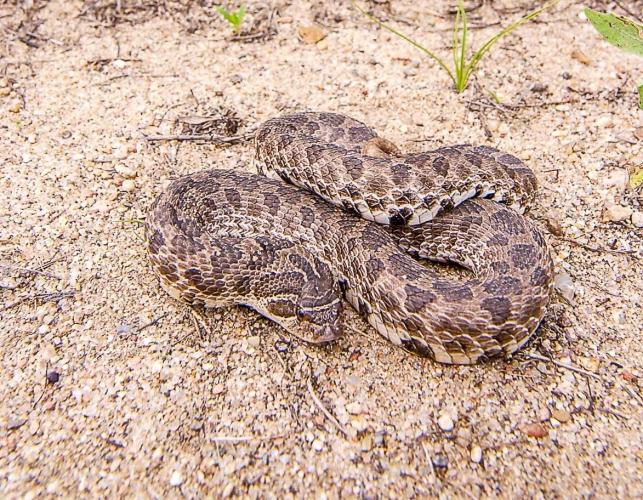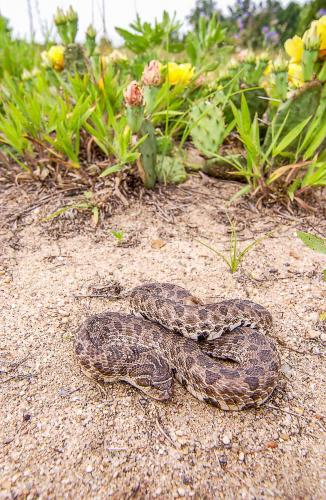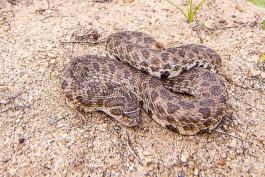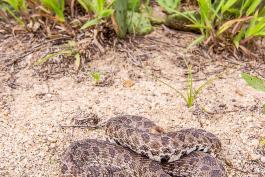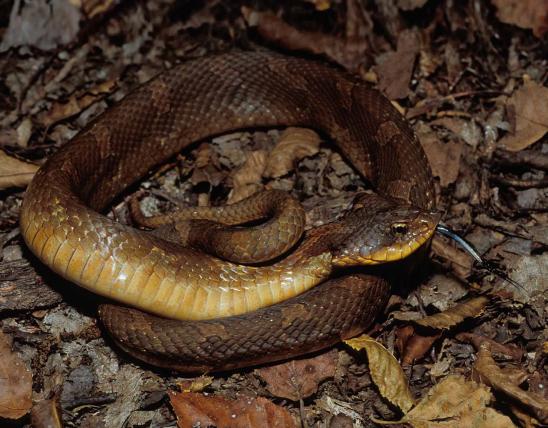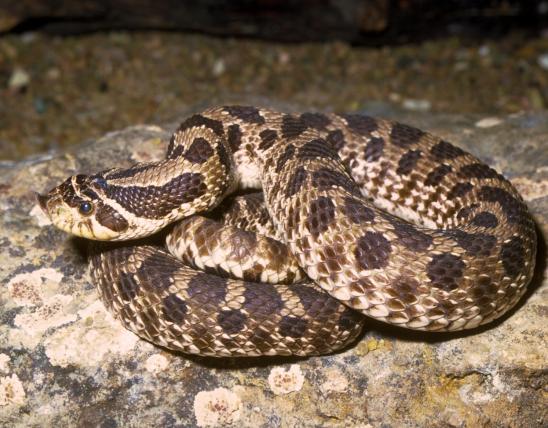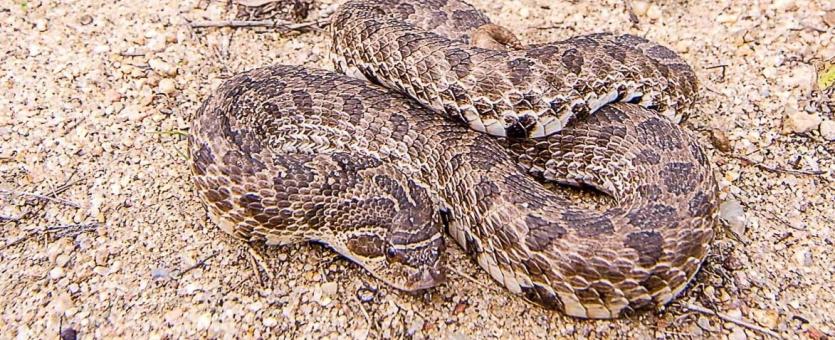
The dusty hog-nosed snake is similar to the plains hog-nosed snake in appearance. The dusty hog-nosed snake is a stout-bodied, small to medium-sized, brown to brown-gray snake with lengthwise rows of dark brown blotches and an upturned snout. The upperside pattern of blotches consists of 1 row along the midline and 2 rows of brown spots on each side. The number of dark blotches down the midline is fewer than 32 in males and fewer than 37 in females. There is usually a dark brown diagonal line through the eye to the angle of the jaw, and, behind it and rather parallel to it, another elongated dark brown blotch running along the side of the head onto the neck. The rostral (nose) scale is upturned and elongated, appearing shovel-like. The belly is wide, mostly colored black from the neck to the underside of the tail; it is edged in yellow blotches on some individuals. The scales on the body are keeled, and the anal plate (the last belly scale, which covers the anal opening) is divided.
This nonvenomous snake is a species of conservation concern and is rare in our state. In Missouri, it occurs only in a few southeastern counties.
Like other hog-nosed snakes, it has several interesting defensive behaviors, including hissing, puffing out its head, thrashing, opening its mouth, and "playing dead." Although hog-nosed snakes rarely bite people, a bite can be painful and result in slight bleeding, discoloration, and swelling at the site of the bite.
Similar species: Missouri has two other hog-nosed snakes:
- The eastern hog-nosed snake (Heterodon platirhinos) is the hog-nosed snake most frequently encountered in Missouri; it occurs statewide. Its coloration and its markings (or lack of markings) are quite variable. Its belly is lighter than the back; the underside of the tail is normally lighter than the belly.
- The plains hog-nosed snake (Heterodon nasicus) was once known only from loess hill prairies in extreme northwestern Missouri; it is probably extirpated from our state. It and the dusty hog-nosed snake used to be considered two subspecies of what was once called the western hog-nosed snake. These two species look very similar. They can be told apart by where they are found (in opposite corners of the state) and by the number of dark upperside midline blotches (for the plains hog-nosed snake, more than 35 in males and more than 40 in females; and for the dusty hog-nosed snake, fewer than 32 in males and fewer than 37 in females).
Adult length: 15 to 25 inches; occasionally to 36 inches.
Restricted to a few counties in southeastern Missouri. In North America, it occurs in disjunct, isolated populations in southwestern Illinois, southeastern Missouri, southeastern Kansas, and eastern parts of Oklahoma and Texas.
Habitat and Conservation
In Missouri, the dusty hog-nosed snake is active from mid-April to mid-October, with most observations reported in May, June, September, and October.
This snake is mainly active during daylight hours, except in the hot summer months in Missouri. In the summer, they are likely active at dusk and dawn when temperatures are more suitable. At night, hog-nosed snakes spend their time in temporary burrows created by using the sharply upturned snout, similar to a shovel, to dig in loose, sandy soils. The well-drained, sandy prairies and savannas in southeastern Missouri are the preferred habitat.
This species is most commonly encountered in the few remaining natural sand prairies and savannas but occasionally can be found on the edges of agricultural fields and urban areas where loose, sandy soil exists.
Overwintering sites are presumed to be in burrows below the frost line dug by mammals or by the snake itself.
When threatened, this harmless species may react in a variety of ways. An individual may try to escape by crawling toward shelter; it may coil and try to hide its head; or it may hiss loudly, spread its head and neck, and strike at the intruder. If the intruder is persistent, the snake will writhe about, open its mouth, extend the tongue, regurgitate any freshly eaten food, roll on its back, and “play dead.” This death-feigning behavior appears to be less frequent with this species than it is with the eastern hog-nosed snake. If left alone, the snake will eventually right itself and move away.
Food
The dusty hog-nosed snake finds prey by sight and odor. It uses its upturned snout to dig animals out of their burrows in sandy soils. Prey consists of amphibians (especially frogs and toads), lizards, birds and their eggs, eggs of many reptiles, and small rodents.
Hog-nosed snakes have a pair of enlarged teeth at the rear of the mouth on the upper jaw; apparently, the teeth are used for holding and deflating toads that are full of air, and to subdue prey by injecting a toxic saliva by prolonged chewing.
Status
A Missouri species of conservation concern, ranked as critically imperiled.
At one time the dusty hog-nosed snake was considered extirpated in Missouri because the last documented specimen was found in 1961, but an individual was captured in 2004 from Scott County. Since this discovery, numerous individuals have been documented from Scott and New Madrid counties. Due to restricted distribution, collection pressure, and loss and alteration of sand prairie and savanna habitat in southeastern Missouri, the dusty hog-nosed snake is listed as a Missouri species of conservation concern. Conservation of this species requires an understanding of the natural history of this species in Missouri, which, unfortunately, is lacking.
The western hog-nosed snake complex (Heterodon nasicus) formerly consisted of three subspecies: the dusty hog-nosed snake (H. n. gloydi), Mexican hog-nosed snake (H. n. kennerlyi), and plains hog-nosed snake (H. n. nasicus). All three subspecies have been elevated to full species. Two of these new species occur in Missouri: the dusty hog-nosed snake in southeastern Missouri (considered critically imperiled), and the plains hog-nosed snake in northwestern Missouri (considered extirpated).
Life Cycle
Little information is available about the reproductive biology of this species. Apparently it is much like that of other kinds of hog-nosed snakes. Courtship and mating presumably occur soon after emergence from overwintering burrows, in mid-April into May, and occasionally in the late summer into fall.
Females likely search for nesting sites in June and July. The female lays some 2–23 eggs beneath the sandy soils. The eggs are positioned more in a line instead of a cluster due to the tunnel-burrowing habits, similar to the plains hog-nosed snake. The eggs likely hatch from August into September.
Females presumably reach sexual maturity within 2–3 years, while males mature in 1–2 years.
Human Connections
Although hog-nosed snakes rarely bite people, a bite can be painful and result in slight bleeding, discoloration, and swelling at the site of the bite. Bites do not pose significant danger to humans, but care must be taken when handling hog-nosed snakes, especially ones conditioned to being hand-fed mice in captivity.
The species name, gloydi, honors Howard K. Gloyd (1902–1978). Gloyd was a Kansas native and taught zoology in Kansas and Michigan before becoming the director of the Chicago Academy of Sciences in 1936, a position he held until 1958. He researched and published on the rattlesnakes and was a consultant to the Illinois Natural History Survey. He is best known for his work on genus Agkistrodon, the venomous group that includes the copperhead and cottonmouth. He moved to Tucson and taught at the University of Arizona from 1958 to 1974, before he retired.
Ecosystem Connections
As predators, dusky hog-nosed snakes serve to check populations of the animals they consume, particularly frogs and toads, but many other animals, too.
This snake's elaborate defensive behaviors, including the ability to spread its head and neck and the physical adaptations that allow it, are reminders that plenty of animals seek this species as prey.
The shovel-shaped snouts of hog-nosed snakes are interesting adaptations for snakes that live and burrow in sandy soils. Spadefoots and narrow-mouthed toads are also species with special adaptations for burrowing in loose substrates. What other animals dig into the soil, and how are their bodies specially equipped for burrowing?
Missouri's sand prairies and sand savannas, the principal habitats for this species in our state, occur on natural levees, terraces, and sandy ridges along the Mississippi River. The soils, which are too high to experience flooding, are sandy, deep, well-drained, nutrient-poor, and usually fairly acidic. Few examples remain in Missouri, and the habitats themselves are considered critically imperiled. Missouri's handful of sand prairies and savannas occur in either the northeast or southeast corners, with habitats in the two regions being quite distinctive.
In addition to the dusty hog-nosed snake, many more plants and animals depend on the sand prairie and savanna habitats of southeastern Missouri, including sand hickory, snout bean, blue curls, American jointweed, creeping St. John's wort, old plainsman, and dotted beebalm. Splitbeard bluestem is a dominant grass, and cottonweeds, prickly pear cactus, narrow-leaved sunflower, and plains puccoon are common. The eastern six-lined racerunner (Aspidoscelis sexlineata sexlineata) mostly occurs to the east of Missouri, but its range extends west into southeastern Missouri, and it occurs in these special Bootheel habitats.
